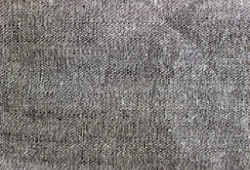Now You Know Bleach Wash of Woven Denims: Analysis of before and after Wash Properties (Part-8)
Friday, 8 March 2019
Edit
Bleach Wash of Woven Denims: Analysis of before and after Wash Properties (Part-8)
S.M. Bappy Rana
Dept. of Textile Engineering
Bangladesh University of Business & Technology
Cell: +8801781630519
Dept. of Textile Engineering
Bangladesh University of Business & Technology
Cell: +8801781630519
Previous Part
4.3 Shrinkage test:
4.3.1The results of Lengthwise shrinkage Measurement:
 |
| Click on image for large size |
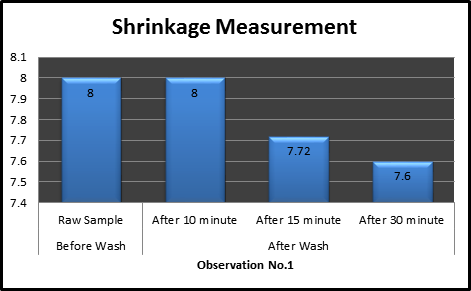 |
| Figure 4.3.2.1: Bar charts of lengthwise Shrinkage measurement |
 |
| Figure 4.3.2.2: Bar charts of lengthwise Shrinkage measurement |
 |
| Click on image for large size |
4.3.4 Graphical Comparison of width-wise shrinkage:
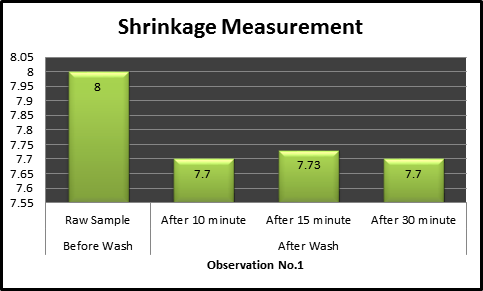 |
| Figure 4.3.4.1: Bar charts of width wise Shrinkage measurement |
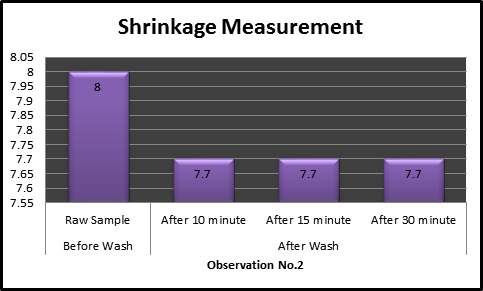 |
| Figure 4.3.4.2: Bar charts of width wise Shrinkage measurement |
From the result it was explored that dimensional change is occurred due to bleach wash. In the lengthwise the shrinkage% is 4.375% that means length is decreased in a small amount due to washing. On the other hand, the shrinkage% in width wise is 3.75% that means is width decreased but less than length wise.
4.4 Count Measurement:
4.4.1 The results of warp Count measurement:
No. of Observation | Before Wash | After 10 minute wash | After 15 minute Wash | After 30 minute Wash | ||||
Value | Average | Value | Average | Value | Average | Value | Average | |
1. | 9 | 9 | 10 | 10 | 11 | 11 | 11 | 11 |
2. | 9 | 10 | 11 | 11 | ||||
3. | 9 | 10 | 11 | 11 | ||||
4.4.2 Graphical Comparison:
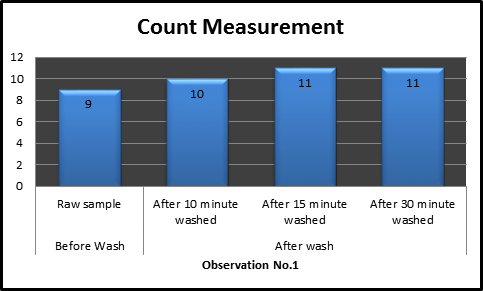 |
| Figure 4.4.2.1: Bar charts of warp Count Measurement |
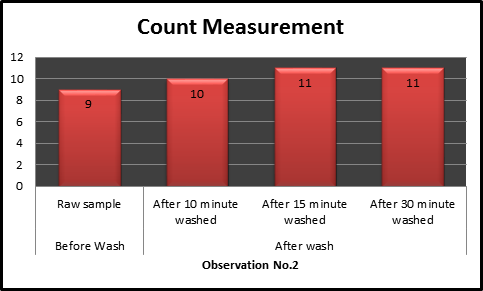 |
| Figure 4.4.2.2: Bar charts of warp Count Measurement |
 |
| Figure 4.4.2.3: Bar charts of warp Count Measurement |
No. of Observation | Before Wash | After 10 minute wash | After 15 minute Wash | After 30 minute Wash | ||||
Value | Average | Value | Average | Value | Average | Value | Average | |
1. | 10 | 10 | 11 | 11 | 12 | 12 | 12 | 12 |
2. | 10 | 11 | 12 | 12 | ||||
3. | 10 | 11 | 12 | 12 | ||||
4.4.4 Graphical comparison:
 |
| Figure 4.4.4.1: Bar charts of weft Count Measurement |
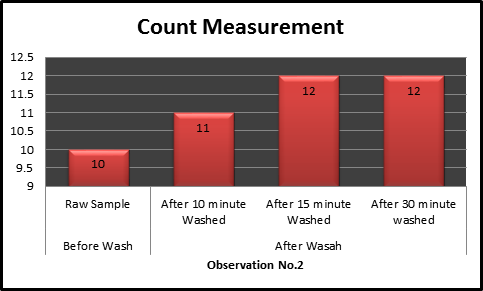 |
| Figure 4.4.4.2: Bar charts of weft Count Measurement |
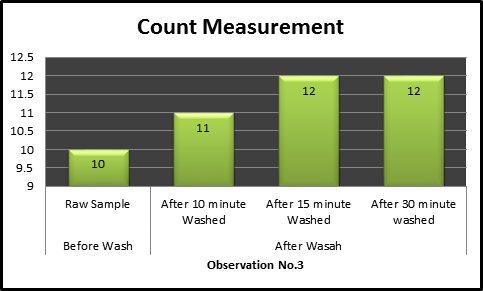 |
| Figure 4.4.4.3: Bar charts of weft Count Measurement |
It has been noticed that bleach washing has a little effect in count . As the denim is 100% cotton, count is measured in English count Ne. It is cleared that there is a difference in warp way and weft way count. Warp way count is lower than weft way count that means weft way yarn is finer than warp way yarn. Due to washing size materials are removed and the yarns become finer. That’s why count increases after washing. Denim becomes soft after washing.
4.5 EPI and PPI Measurement:
4.5.1 The results of EPI Measurement:
No. of Observation | Before Wash | After 10 minute Wash | After 15 minute Wash | After 30 minute Wash | ||||
Value | Average | Value | Average | Value | Average | Value | Average | |
1. | 75 | 75 | 75 | 76 | 76 | 77 | 76 | 77 |
2. | 76 | 77 | 77 | 77 | ||||
3. | 75 | 77 | 77 | 77 | ||||
4.5.2 Graphical comparison:
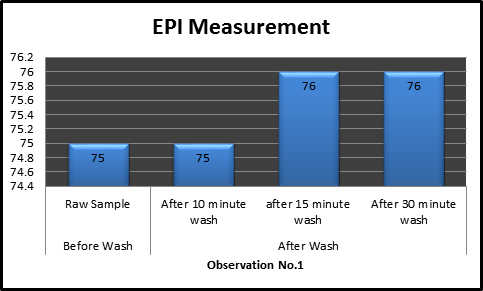 |
| Figure 4.5.2.1: Bar charts of EPI measurement |
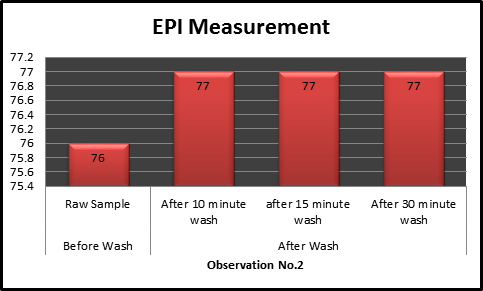 |
| Figure 4.5.2.2: Bar charts of EPI measurement |
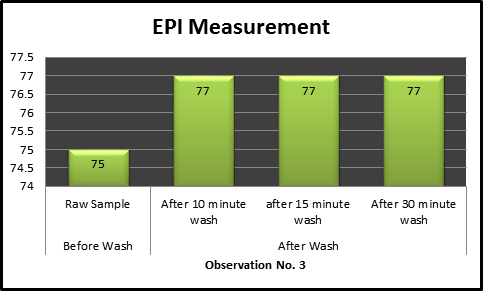 |
| Figure 4.5.2.3: Bar charts of EPI measurement |
No. of Observation | Before Wash | After 10 minute Wash | After 15 minute Wash | After 30 minute Wash | ||||
Value | Average | Value | Average | Value | Average | Value | Average | |
1. | 44 | 45 | 46 | 46 | 47 | 46 | 46 | 47 |
2. | 45 | 46 | 46 | 47 | ||||
3. | 45 | 47 | 46 | 48 | ||||
4.5.4 Graphical Comparison:
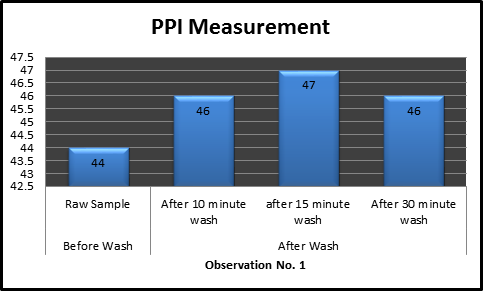 |
| Figure 4.5.4.1: Bar charts of PPI measurement |
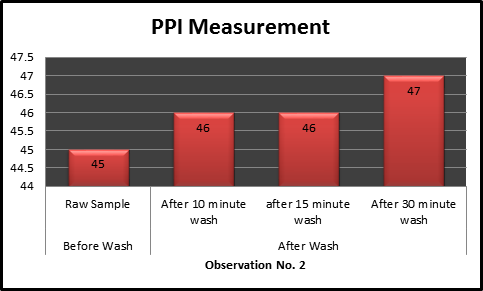 |
| Figure 4.5.4.2: Bar charts of PPI measurement |
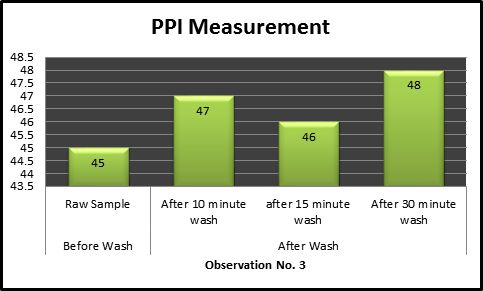 |
| Figure 4.5.4.3: Bar charts of PPI measurement |
It was revealed that bleach washing has a little effect in EPI and PPI of woven denim apparel. it is further noted that due to different duration of washing EPI, PPI was little changed.
4.6 Comparison of color depth
4.6.1 The results of color depth comparison:
No of Observation | Before Wash Parameter | After 10 minute Wash parameter | After 15 minute Wash parameter | After 30 minute Wash parameter |
1. | 5 | 3 | 2 | 1 |
2. | 5 | 3 | 2 | 1 |
Related:
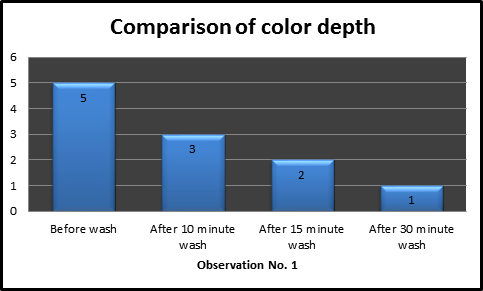 |
| Figure 4.6.2.1: Bar charts of color depth |
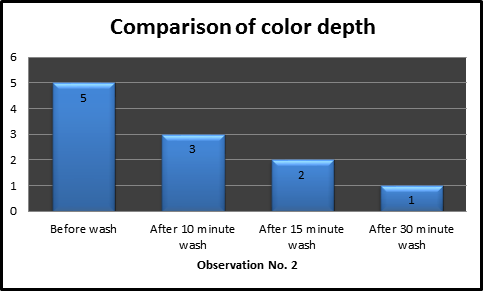 |
| Figure 4.6.2.2: Bar charts of color depth |
It was investigated from the project work that there was a huge change in color depth due to bleach wash on woven denim apparels. When duration of washing increases, shade becomes lighter even temperature and concentration remain same at the whole process.
Chapter 5
CONCLUSION
CONCLUSION
Popularity of apparel washing especially on denim apparel (jeans) in the world market has been increasing day by day. In this project work it has been explored that, bleach washing with a bleaching powder gives a used look appearance on jeans. The effects of bleach washing on jeans under investigation could be realized by the comparison of before and after wash properties namely tensile strength, GSM, EPI, PPI, Dimensional stability, count and color depth variation. Tensile strength, GSM, dimensional stability, color depth are decreased and count, EPI, PPI are increased due to bleach wash treatment. It is further noted that pre- washed jeans are almost stiff and harder than the bleach washed jeans.
It has also been explored that as a cost effective method bleaching treatment with a bleaching powder can produce a fashion apparel and a value added product with a high wear performance. So in order to meet the quick change of customer demand for fashion apparel, bleach washing can be an effective way.
REFERENCES
- Kashem, M.A., Garments Merchandising, 1st edn., Lucky-one traders, Dhaka, Bangladesh, pp 69-71(2008).
- Khan, M. M. R., Mondal, M. I. H., Alam, A. B. M.F. and Hossain, M. H., Modification of Denim Garment with the Treatment of Bleaching Powder, Can. J. on Chemical Engineering &Technology, 3(2): pp. 30-36 (2012a).
- Khan, M. M. R., Mondal, M. I. H. and Uddin, M. Z., Sustainable Washing for Denim Garments by Enzymatic Treatment, Journal. of Chemical Engineering, The Institution of Engineers (IEB), ChE 27(1): 27- 31 (2012b).
- Razzaque, M. A., Garment & Textile Merchandising, 1st ed. popular Publications, Dhaka, pp. 223-226 (2004).
- Booth, J.E., B. Sc. F.T.L., Principles of Textile Testing , Heywood , London ,3rd edition 1968.
- Grieve, M., Biermann, T. and Schaub, K., The use of indigo derivatives to Dye Denim material, Science & Justice, 46: 15-24 (2006).
- Khan, M.M.R., Mondal, M.I.H., Bleach washing combined with pumice stone for the modification of denim garments. Oriental journal of chemistry, 28(3) Pp. 1241-1247 (2012).
- Khan, M.M.R., Mondal, M.I.H.,Uddin ,M.Z., Effects of bleach wash on the physical and mechanical properties of denim garments, ICME 14- FL- 022 (2011)
- Cookson, P. G., Relationships Between Hygral Expansion, Relaxation Shrinkage, and Extensibility in Woven Wool Fabrics, Textile Res. J. 62: 44-51 (1992).
- Morries, C. E., & Harper, R. J., Comprehensive View on Garment Dyeing and Finishing, American Dyestuff Reporter, 83: 132-136 (1994).
- J.O. Otutu, E. Osabohien and E.M. Efurhievwe. Orient. J. Chem. 26(1): 31-38 (2010).
- Morries, C. E., & Harper, R. J.,Comprehensive View on Garment Dyeing and Finishing, American Dyestuff Reporter, 83: 132-136 (1994).
- Sangita, S., Kumar, P. S. and Chandran, M.R., Types of Stone Wash & Their Effects on the Denim Fabric, The Indian Textile Journal, (2010).
- Morton. W.E., Hearle. J.W.S., Physical properties of textile fibres. New edtition (2010)
- Islam, M. T., Garments Washing & Dyeing, Ananto Publications, Dhaka, pp. 220-222 (2010).
- R. B Beevers. “ Experiments in fibre physics”, Butterworth, London,( 1970)
Sumber http://textilelearner.blogspot.com

